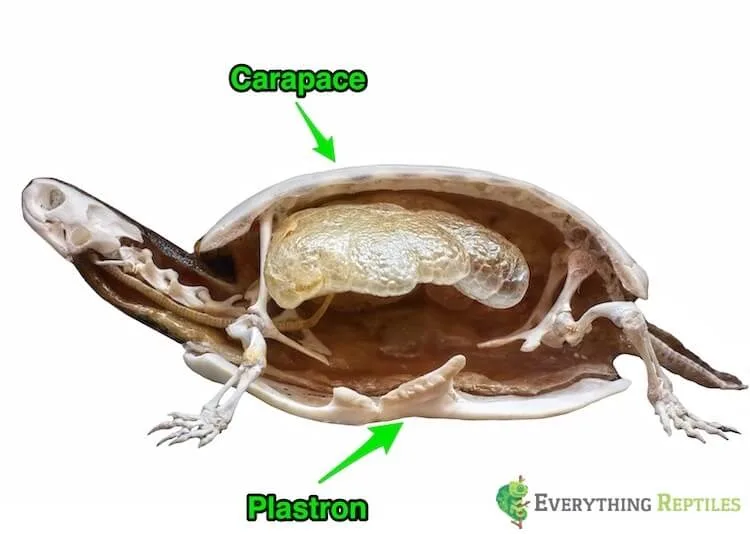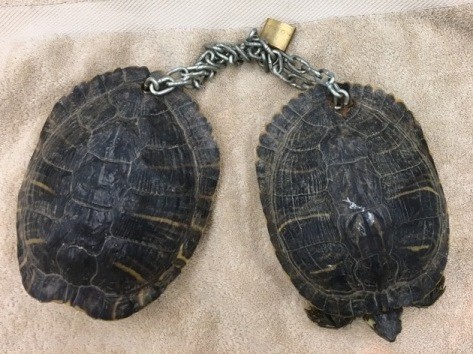How Does Turtle Shell Grow

Turtle shells are one of the most interesting things about these creatures. The shell is actually made up of about 60 different bones that are all connected together. The top part of the shell is called the carapace and the bottom part is called the plastron.
These bones are covered with a thin layer of skin that has tiny scales on it. As turtles grow, their shells also grow larger.But how does this growth happen?
It turns out that turtle shells aren’t like our own bones where they just get bigger as we age. Instead, new bone material is constantly being added to the outer edge of the shell. This process is called ossification and it happens throughout a turtle’s life.
A turtle shell is made up of many different plates that are held together by ligaments. The bottom part of the shell is called the plastron, while the top part is called the carapace. Both parts of the shell are covered in a layer of keratin, which helps to protect the turtle from predators and other dangers.
As a turtle grows, so does its shell. The plates that make up the shell will slowly grow and spread apart, allowing the turtle to get larger over time. This process can take months or even years to complete, depending on the species of turtle.
When fully grown, a turtle’s shell can be quite impressive!
How turtle shells evolved… twice – Judy Cebra Thomas
Turtle Shell Facts
Turtle shells are one of the most interesting things about these creatures. Here are some turtle shell facts that you may find interesting.The shell is made up of two parts, the upper carapace and the lower plastron.
The carapace is fused to the ribs and spine, while the plastron is not. This gives turtles extra protection against predators.There are over 60 different species of turtles, and each has a slightly different shell shape.
For example, box turtles have hinged shells that allow them to close up tightly when threatened.Turtles can withdraw into their shells for protection, but they cannot completely escape predators this way. Some species have evolved special adaptations to help them avoid being eaten.
For example, many sea turtles have spikes on their shells that make it difficult for predators to get a good grip.
Turtle Scutes
Turtle scutes are the protective plates that cover a turtle’s shell. They are made of keratin, the same protein that makes up human hair and nails. The scutes overlap one another like shingles on a roof, providing a tough barrier against predators and other threats.
Over time, the scutes will wear down and need to be replaced. This process is known as molting, and it typically happens once or twice a year.There are two types of scutes: marginal scutes line the edge of the shell, while vertebral scutes run along the centerline (backbone).
Each type serves a different purpose. The marginals provide extra protection for vulnerable areas like the head and limbs, while the vertebrals help support the weight of the turtle’s body.While all turtles have scutes, they come in a wide variety of sizes, shapes, and colors depending on the species.
Some turtles even have patterns or designs on their shells that are unique to them. Regardless of their appearance, all turtle scutes perform an important role in keeping these amazing creatures safe from harm!
How Many Scutes on a Turtle Shell
Turtles are a popular pet, and their scutes are one of their most defining characteristics. But how many scutes does a turtle have?The answer depends on the type of turtle.
Sea turtles can have up to four rows of scutes, while land turtles typically have two or three rows. The number of scutes in each row also varies by species. For example, red-eared slider turtles usually have 12 scutes in each row, while box turtles may have as few as 5 scutes per row.
While the number of scutes on a turtle’s shell can vary, they all serve the same purpose: to protect the turtle’s body from predators and the environment. So whether your turtle has 2 rows or 4 rows of scutes, be sure to give them plenty of love and care!
What are Turtle Shells Used for
Turtle shells are used for a variety of purposes, including protection, camouflage, and as a source of food.Turtles are reptiles that have a protective shell that covers their bodies. The shell is made up of two parts: the carapace (upper shell) and the plastron (lower shell).
The carapace and plastron are connected by hinges at the turtle’s sides, allowing them to close their shells completely for protection.The shell provides turtles with several advantages. First, it protects them from predators and other animals that might try to eat them.
Second, theshell camouflages turtles from their prey, making them difficult to spot. Finally, the shell helps turtles to float in water and stay warm in cold weather.In some cultures, turtle shells are also used for medicinal purposes or as lucky charms.
For example, some Native American tribes believe that wearing turtle shells can help heal broken bones.

Credit: www.chattnaturecenter.org
How Does a Turtles Shell Get Bigger?
A turtles shell is made up of about 60 different bones that are connected by muscles, ligaments, and tendons. The shell grows as the turtle grows because the bones increase in size and new layers of keratin are added to the shell.
Do Turtle Shells Grow With Them?
Turtle shells do not grow with them. The shell is actually a part of the turtle’s skeleton and is made up of 60 different bones that are fused together. The top part of the shell is called the carapace, while the bottom portion is called the plastron.
Both parts are connected by a bridge, which runs along the turtle’s spine.As turtles grow, they periodically shed their old shell and grow a new, larger one. This process, known as molting, usually happens once a year for younger turtles and every two to three years for adults.
During this time, the turtle’s body expands and its bones start to separate from each other before new growth begins. Once the new shell has grown completely, the turtle will harden and darken it through a process known as sclerotization.The size and shape of a turtle’s shell can vary greatly depending on the species.
For example, box turtles have high domed shells that protect them from predators, while sea turtles have streamlined shells that help them swim faster in water.
How Do Turtle Shells Evolve?
Turtle shells are one of the most unique features of these animals and have evolved over time to become the hard, protective shells we see today. The shell is actually made up of two parts – the carapace (upper shell) and plastron (lower shell) – which are connected together by a bridge. Both parts of the shell are covered in a layer of keratin, which helps to make them strong and waterproof.
The first turtles appeared on Earth around 220 million years ago and their shells would have been much different to what we see today. Over time, as they adapted to different environments and predators, their shells began to change and evolve. For example, some turtles developed longer necks so that they could reach food that was out of reach, while others grew spikes on their shells to deter predators.
One of the most interesting things about turtle shells is that they can continue to grow throughout an individual’s life. This is because there are growth plates located at the edges of the carapace and plastron, which allow the shell to slowly expand as the turtle gets older. So, if you ever come across a turtle whoseshell seems too big for its body, it’s probably because it’s an older individual!
Where Does a Turtle Shell Grow From?
A turtle’s shell is made up of two parts: the upper carapace and the lower plastron. The carapace is the hard, protective top part of the shell, while the plastron is the soft underside. Turtles can retract their head, legs and tail into their shells for protection from predators or other threats.
Turtles’ shells grow along with them as they get older. A young turtle’s shell will start to develop within a few weeks after it hatches from its egg. As the turtle grows, so does its shell.
The shell will continue to grow until the turtle reaches adulthood, at which point it will stop growing any larger.While a turtle’s shell may appear to be one solid piece, it is actually composed of many smaller plates that are joined together. These plates are made of keratin, the same material that makes up our fingernails and hair.
How Fast Does a Turtle Shell Grow?
A turtle’s shell grows as the turtle grows. The growth rate depends on the species of turtle, but generally, a turtle’s shell will grow about as fast as the turtle itself. A young turtle’s shell will usually grow faster than an adult’s because the young turtle is growing faster overall.
There are some things that can affect how fast a turtle’s shell grows. For example, if a turtle doesn’t have enough calcium in its diet, its shell may not grow as quickly or be as strong as it otherwise could be. Additionally, if a turtle is sick or under stress, itsshell may also grow more slowly.
What Are the Causes of Shell Rot in Turtles and How Can It Be Treated?
Shell rot in turtles is caused by various factors, including poor water quality, inadequate diet, and injuries. If left untreated, turtle shell rot symptoms can worsen, leading to shell deformities and infections. To treat this condition, proper tank maintenance, a well-balanced diet, and regular veterinary check-ups are essential. Prompt intervention can help prevent further complications and ensure the turtle’s overall health and well-being.
Can Bearded Dragons Eat Crickets to Help Their Shell Grow?
Bearded dragons can consume crickets suitable for bearded dragons to aid in shell growth. These protein-packed insects provide essential nutrients like calcium and phosphorus, crucial for a healthy shell. As a nutritious and natural food source, crickets offer a balanced diet for bearded dragons, promoting proper development and strengthening of their shells.
Do Turtle Shells Grow Or Shed?
As you may know, turtles are reptiles and thus have scaly skin. Unlike other reptiles though, turtles also have a hard shell that covers their back and sides. This shell is actually made up of about 60 different bones that are covered by keratin – the same substance that makes up human fingernails.
The top part of the turtle’s shell is called the carapace while the bottom part is referred to as the plastron.Now onto your question – do turtle shells grow or shed? The answer is both!
When turtles are young, their shells grow rapidly as they mature. Once they reach adulthood however, growth slows down considerably and sometimes even stops altogether. In terms of shedding, a turtle will typically “shed” its old shell every few years as it grows a new one.
This process is known as ecdysis and usually happens during the warmer months when conditions are more favorable for molting (i.e., there’s plenty of food available).So there you have it! Turtles definitely do both grow and shed their shells throughout their lifetime – it’s just at different rates depending on their age.
Conclusion
As turtles grow, their shell expands through a process of molting. In order to molt, a turtle will first stop eating and drinking for a period of time. This helps the turtle to shed its old shell.
Once the old shell is shed, the turtle will begin to eat and drink again in order to help its new shell grow. The new shell will continue to grow until the turtle reaches its full size.